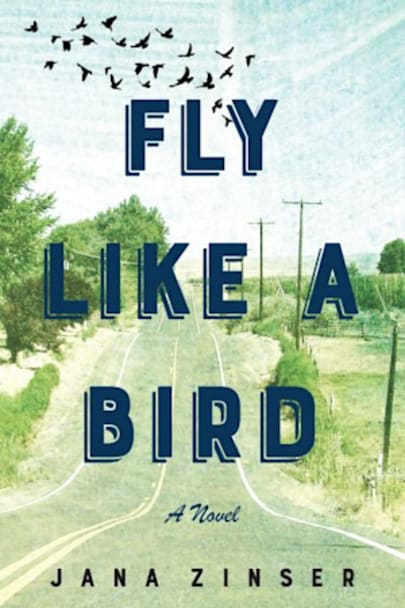A coming-of-age story of a young white girl who fights racism and betrayal as she tries to unravel the truth about her parents’ deaths and escape the town that lied to her. Ivy, a young girl growing up in a small town in the 70s where everyone knows everything, discovers her family and the people in her town are keeping secrets about the night a car crash killed her parents. The secrets she … parents.
The secrets she uncovers and her efforts to leave the town that lied to her, force Ivy to confront betrayal, death, racism, and the meaning of family.
more



Fly Like a Bird presents plot and subplot lines compelling enough to keep the reader turning the pages, and heart racing at times. A child grows into a young woman, always struggling to leave a rural small town and dysfunctional family. One situation after another pulls her back, threatening to never let her go.
But the soul and heart of this novel are the characters. To use Jana Zinser’s own description, the people are “an odd assortment of mismatched characters with brooding secrets and peculiar eccentricities.” Those who populate the story are colorful, loving, hateful, sad, evil, heroic and courageous, but never stereotypical. Full disclosure: this writer grew up in the time of this novel, in a town not that different from the one in this story. I knew all these people.
I fault the book only for the fact that the “evil” characters could have been more fully developed. I don’t dispute that evil exists, just that I believe no one is born that way. Their journey to hell should be more fully explained.
Another character is nature. Setting is pivotal. The four seasons of the Midwest, complete with tornadoes, flooding rains, as well as stunning beauty, are artfully rendered. Lines such as “Grasshoppers popped up and down like popcorn in the tall summer grass” paints a memory I had almost forgotten.
The reader who did not grow up rural may be forgiven for doubting that some of the people and some of the non-human animals would ever behave in the way that is presented, especially the birds. Give the story a nod toward magical realism (Gabriel Garcia Marquez) and it solves that problem. Reflect on the people in Steinbeck’s Cannery Row and you can just enjoy it. Either way, that’s pretty good company.
Or if, like me, you grew up in 1950s rural culture, you will know there’s nothing magical about the realism in this book. It’s just the way the world works.
I received a free electronic copy of this historical novel from Netgalley, Jana Zinser, and BQB Publishing. Thank you all for sharing your hard work with me. I have read this novel of my own volition, and this review reflects my honest opinion of this work. I am pleased to recommend this noir-style Iowa historical to friends and family. It is an interesting read, telling tales of what it takes to make -or break- a family.
Time moves on from a brief stop in 1959 to 1966 through 1986 in the town of Coffey, Iowa, a wide spot in the road. We watch as Ivy is orphaned while still a babe-in-arms and is raised by her paternal grandmother. Violet Taylor is the mother of three sons – Walter is a postman and single, Tommy is married to Hattie with two children, Angela who left Coffey at 17 and never returned, and Russell, who is undiagnosed autistic. Tommy works at the Coffey Sewage plant, drinks a bit too much and bowls and does mischief with his best friend Ruben Smith. Ruben Smith is a farmer, childless, married to Patty, who eats away her angst and won’t leave her house. Violet’s youngest son Bobby was killed in a car wreck in 1959 when his new blood-red Pontiac lost grip on black ice and was creamed by a semi. With the absence of Bobby and his wife Barbara, their daughter Ivy was raised in the white Victorian at 4120 Meadowlark Lane by Violet.
Charlie Carter is the local law, bought and paid for by Coffey’s only bank manager and Mayor, Conrad Thrasher. The mayor’s son Weston is ‘that kid’ who shoots cats and acts without conscious most of the time. The diner is peopled by some sweet ladies, the librarian in legally blind, and the black barber and beauty shop is open only on Saturday in Pinky’s living room. The white barber left town years ago as did the beauty shop lady. The black community is confined to Mulberry Street, which parallels the train track, by hook and by crook – a black person can only get a bank loan on Mulberry Street houses. Ivy’s best friend Maggie Norton, daughter of Otis and Pinky, lives on Mulberry Street. Otis works maintenance at the local college, and Pinky does the hair of the back community and makes awesome pieced quilts. This may seem like too much cast for our story, but they are each very much necessary. This is an excellent picture of growth by generation, a lesson we must all learn.
Fly Like a Bird is a coming of age tale, following not only Ivy but also Shirley’s sons Ben and Justin, Weston Thrasher, the lawyer’s son Nick Jerome, Jesse Marshal, son of the new white beauty shop owner, and Ivy’s best friend Maggie Norton.
We tend to think of blatant racism as a strictly southern problem during these turbulent years of the ’60s, ’70s, and ’80s. Not so – all of us Americans are slow learners, I have found. Fly Like a Bird is a message of hope that racism will end – hopefully in our lifetime but certainly in that of our children.